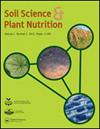Changes in chemical form of phosphorus in rice bran during fermentation process as determined by 31P nuclear magnetic resonance spectroscopy
IF 1.8
4区 农林科学
Q3 ENVIRONMENTAL SCIENCES
引用次数: 1
Abstract
ABSTRACT Rice bran contains appreciable amount of phosphorus (P), which can be used as P fertilizers. The efficiency of the P in the rice bran to plants, however, is low, and the fermentation of the rice bran is proposed to improve the P availability for plants. In the present study, 20 kg of rice bran was aerobically fermented by adding 5 kg of rice husk, 0.025 kg of mulch, and 7 L of water and incubating for 35 days with 6 times of stirring, and the changes in the chemical form of P during the fermentation process were investigated by 31P nuclear magnetic resonance spectroscopy and chemical extraction. Most part (84%) of P in the raw rice bran was myo-inositol-1,2,3,4,5,6-hexaphosphate (I6P), which is not available for plants. During the fermentation process, I6P was degraded and transformed into plant-available phosphate anions (orthophosphate). The proportions of the orthophosphate increased to 68% after incubating for 19 days with two times of stirring and 92% after incubating for 35 days with six times of stirring. After the fermentation, the orthophosphate was present as plant available precipitates associated with magnesium and the other monovalent cations. In conclusion, rice bran contains low-available I6P as a major P form, and the fermentation of rice bran accelerates the cleavage of the ester bond of I6P and results in the increased proportion of orthophosphate with high availability to plants.用31P核磁共振谱法测定米糠发酵过程中磷的化学形态变化
米糠中含有一定量的磷,可作为磷肥使用。然而,米糠中磷对植物的利用效率较低,建议通过米糠发酵提高植物对磷的利用效率。本研究以20 kg米糠为原料,加入5 kg稻壳、0.025 kg地膜、7 L水,搅拌6次,发酵35 d,采用31P核磁共振波谱法和化学萃取法研究发酵过程中P的化学形态变化。原料米糠中P的大部分(84%)是肌醇-1,2,3,4,5,6-六磷酸(I6P),植物无法获得。在发酵过程中,I6P被降解转化为植物可利用的磷酸阴离子(正磷酸盐)。2次搅拌培养19 d后,正磷酸盐的比例达到68%;6次搅拌培养35 d后,正磷酸盐的比例达到92%。发酵后,正磷酸盐以植物可利用沉淀物的形式与镁和其他一价阳离子结合。综上所述,米糠以低效价I6P为主,米糠发酵加速了I6P酯键的裂解,提高了植物高效价正磷酸盐的比例。
本文章由计算机程序翻译,如有差异,请以英文原文为准。
求助全文
约1分钟内获得全文
求助全文
来源期刊

Soil Science and Plant Nutrition
农林科学-农艺学
CiteScore
4.80
自引率
15.00%
发文量
56
审稿时长
18-36 weeks
期刊介绍:
Soil Science and Plant Nutrition is the official English journal of the Japanese Society of Soil Science and Plant Nutrition (JSSSPN), and publishes original research and reviews in soil physics, chemistry and mineralogy; soil biology; plant nutrition; soil genesis, classification and survey; soil fertility; fertilizers and soil amendments; environment; socio cultural soil science. The Journal publishes full length papers, short papers, and reviews.
 求助内容:
求助内容: 应助结果提醒方式:
应助结果提醒方式:


